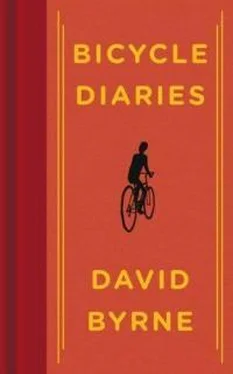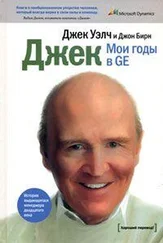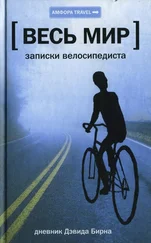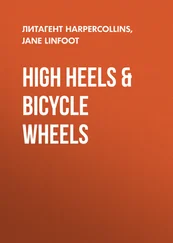I am terrified. Many of the guys that originally turned PowerPoint into a software program are present. What are they going to think of what I did with their invention? Well, couldn’t they just get up to talk about it? They could call me out and denounce me!
Luckily, I’m not talking about the details of the programming but about the ubiquity of the software and how, because of what it does and how it does it, it limits what can be presented—and therefore what is discussed. All media do this to some extent—they do certain things well and leave other things out altogether. This is not news, but by bringing this up, reminding everyone, I hope to help dispel the myth of neutrality that surrounds many software programs.
I also propose that a slide talk, the context in which this software is used, is a form of contemporary theater—a kind of ritual theater that has developed in boardrooms and academia rather than on the Broadway stage. No one can deny that a talk is a performance, but again there is a pervasive myth of objectivity and neutrality to deal with. There is an unspoken prejudice at work in those corporate and academic “performance spaces”—that performing is acting and therefore it’s not “real.” Acknowledging a talk as a performance is therefore anathema. I want to dispel this myth of authenticity somewhat, in an entertaining and gentle way.
The talk goes fine. I can relax, they’re laughing. Bob Gaskins, Dennis Austin, and Peter Norvig are all here. Bob Gaskins was one of the guys who refined the original program and realized its potential. Bob declined to be introduced, so I stick with a picture of a concertina when I mention his name. (He’s retired and buys and sells antique concertinas now.) That gets a laugh. He tells me afterward that he likes the PowerPoint-as-theater idea, which is a relief. I mean, there is a lot of hatred for this program out there, and a lot of people laugh at the mere mention of bullet points, so he must feel kind of vulnerable.
In working on these pieces, and others, I have become aware that there is a pyramid of control and influence that exists between text, image, and sound. I note that today we give text a preferential position: a label under an image “defines” that image even if it contradicts what we can see. I wonder, in a time before text became ubiquitous, was image (a symbol, a gesture, a sign) the most influential medium? Did sound—singing, chanting, rhythm—come in second, and text, limited as it might have been thousands of years ago, come in third? Was text once a handmaiden to image and sound and then gradually managed to usurp their places and take control? Did the pyramid of communicative power at some point become inverted?
Wittgenstein famously said, “The limits of my language are the limits of my mind. All I know is what I have words for.” I am a prisoner of my language.
This presupposes that conscious thought cannot happen without verbal or written language. I disagree. I sense a lot of communication goes on nonverbally—and I don’t mean winks and nods. I mean images get ahold of us, as do sounds. They grab and hold us emotionally. Smells too. They can grip in a way that is hard to elucidate verbally. But maybe for Ludwig it just wasn’t happening. Or maybe because he couldn’t express what sounds, smells, and images do in words he chose to ignore them, to deny that they were communicating.
Let’s Open a Club!
I hail a cab and fold my bike, throw it in the trunk, and head back to San Francisco. The cabdriver would be perfect cast as Ignatius from the novel A Confederacy of Dunces. He’s a large man wearing big shades, with a shaved head and, on this unusually hot day for San Francisco, a rolled-up, wooly winter hat. He recognizes me and tells me he knows that the lead guitarist from Talking Heads lives in Marin (he means Jerry Harrison). He also knows where Dana Carvey lives, so he proceeds to try to convince me to get together with Dana and start a club. “Nice tables, some drinks, some comedy, and good, wholesome music: how could we lose?”
Then he moves on to discuss the “negro infection,” by which I think he means the lewd and violent lyrics of gangsta rap. His own musical favorite is Huey Lewis, whom he thinks needs to be played on the radio more. He suggests that maybe Huey and I could both play at the club, yeah!
At the airport, my flight is delayed, and I can hear the businessman behind me saying, “Isn’t that the worst slide you’ve ever seen?” as he holds up a printout of a PowerPoint slide—a triangle with words on it.
New York
Iride my bike almost every day here in New York. It’s getting safer to do so, but I do have to be fairly alert when riding on the streets as opposed to riding on the Hudson River bike path or similar protected lanes. The city has added a lot of bike lanes in recent years, and they claim they now have more than any other city in the United States. But sadly most of them are not safe enough that one can truly relax, as is possible on the almost completed path along the Hudson or on many European bike lanes. That’s changing, bit by bit. As new lanes are added some of them are more secure, placed between the sidewalk and parked cars or protected by a concrete barrier.
Between 2007 and 2008 bike traffic in New York increased 35 percent. Hard to tell if the cart is leading the horse here—whether more lanes have inspired more bicycle usage or the other way around. I happily suspect that for the moment at least, both the Department of Transportation and New York City cyclists are on the same page. As more young creative types find themselves living in Brooklyn they bike over the bridges in increasing numbers. Manhattan Bridge bike traffic just about quadrupled last year (2008) and the bike traffic on the Williamsburg Bridge tripled. And those numbers will keep increasing as the city continues to make improvements to bike lanes and adds bike racks and other amenities. In this area the city is, to some extent, anticipating what will happen in the near future—a lot more people will use bikes for getting to work or for fun.
On a bike, being just slightly above pedestrian and car eye level, one gets a perfect view of the goings-on in one’s own town. Unlike many other U.S. cities, here in New York almost everyone has to step onto the sidewalk and encounter other people at least once a day—everyone makes at least one brief public appearance. I once had to swerve to avoid Paris Hilton, holding her little doggie, crossing the street against the light and looking around as if to say, “I’m Paris Hilton, don’t you recognize me?” From a cyclist’s point of view you pretty much see it all.
Just outside a midtown theater a man rides by on a bike—one of those lowriders. He’s a grown man, who seems pretty normal in appearance, except he’s got a monstrously huge boom box strapped to the front of the bike.
I ride off on my own bike and a few minutes later another boom-box biker passes by. This time it’s a Jane-Austen-reading, sensible-shoe-wearing woman. She’s on a regular bike, but again, with a (smaller) boom box strapped to the rear . . . I can’t hear what the music is.
City Archetypes
There is a magazine in a rack at the entrance to my local Pakistani lunch counter called InvAsian: A Journal for the Culturally Ambivalent.
What is it about certain cities and places that fosters specific attitudes? Am I imagining that this is the case? To what extent does the infrastructure of cities shape the lives, work, and sensibilities of their inhabitants? Quite significantly, I suspect. All this talk about bike lanes, ugly buildings, and density of population isn’t just about those things, it’s about what kinds of people those places turn us into. I don’t think I’m imagining that people who move to L.A. from elsewhere inevitably lose a lot of that elsewhere and eventually end up creating L.A.-type work and being L.A.-type people. Do creative, social, and civic attitudes change depending on where we live? Yes, I think so. How does this happen? Do they seep in surreptitiously through peer pressure and casual conversations? Is it the water, the light, the weather? Is there a Detroit sensibility? Memphis? New Orleans? (No doubt.) Austin? (Certainly.) Nashville? London? Berlin? (I would say there’s a Berlin sense of humor for sure.) Düsseldorf? Vienna? (Yes.) Paris? Osaka? Melbourne? Salvador? Bahia? (Absolutely.)
Читать дальше









